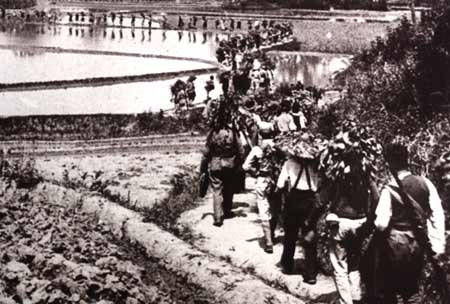Mainstay of the War of Resistance Against Japan (July 1937-August 1945)

On July 7, 1937, Japanese troops attacked Lugouqiao Bridge (Marco Polo Bridge) in Wanping County in the suburbs of Beiping. The defending Chinese troops rose to fight the enemy, marking the beginning of the nationwide War of Resistance Against Japan.
In July 1937, the Japanese imperialists launched an all-out war of aggression against China. In the ensuing eight years of the War of Resistance Against Japan, the Chinese Communist Party held high the banner of national unity and armed resistance against Japan, and stood in the forefront of the struggle for national liberation from beginning to end.
The Chinese Communist Party drew up a program for the anti-Japanese war. It called on Chinese forces to fight the enemy on all fronts and prepare for a protracted war against the Japanese aggressors. This policy paved the way for the final victory of the War of Resistance Against Japan. Under the leadership of the Party, the Eighth Route Army, the New Fourth Army and other anti-Japanese armed forces of the people penetrated deep behind enemy lines to mobilize the masses, peasants in particular, to launch guerrilla warfare. Anti-Japanese base areas and anti-Japanese democratic governments were set up behind enemy lines. Armed forces and civilians in the base areas thus gradually became the main forces in fighting the Japanese aggressors. Yan'an, headquarters of the Party Central Committee and capital of the Shaanxi-Gansu-Ningxia Border Region, became a command centre of the anti-Japanese war and a sacred place of revolution for all Chinese patriots.

On August 25, the Chinese Red Army in the north was redesignated as the Eighth Route Army, with Zhu De as general commander, Peng Dehuai, deputy general commander, Ye Jianying, chief of staff, and Ren Bishi, director of the Political Department. Shown here is General Commander Zhu De calling on the soldiers of the Eighth Route Army to go to the front of the anti-Japanese war.

On October 18, the 120th Division of the Eighth Route Army ambushed the transportation line of the Japanese army in the south of the Yanmenguan in Shanxi Province. The next day, the 129th Division attacked the Yangmingpu Airport in Daixian County, Shanxi Province, during the night. Shown here are Eighth Route Army soldiers ambushing Japanese military trucks. When the war turned into a stalemate, the Party Central Committee raised three slogans-"Persist in resistance and oppose capitulation, persist in unity and oppose a split, and persist in progress and oppose retrogression". On the one hand, the Party led the armed forces and civilians behind enemy lines to fight bitter battles against Japanese aggressors. On the other hand, it tried every means to maintain the united front in fighting Japan, for which it waged struggles on just grounds, to its advantage and with restraint against the Kuomintang diehards who insisted on opposing the Communist Party and appeasing the Japanese aggressors at the same time, the Party made remarkable progress in mass work and united front work in the Kuomintang-controlled areas.

From August 22 to 25, 1937, the Politburo of the CPC Central Committee convened an enlarged meeting in Fengjia Village, Luochuan, in northern Shaanxi Province. During the meeting, the Party formulated the policy of total resistance against Japan. It decided to carry out independent guerrilla warfare behind enemy lines and reduce rent and interest. Shown here are the site of the Luochuan meeting and the document passed at the meeting.
At these times, though the war was meeting with severe difficulties, the Party led the armed forces and civilians behind enemy lines in arduous struggles against the policies of "mopping-up operations", "nibbling" and "cleaning-up of villages" practiced by the Japanese aggressors. In the meantime, it strengthened the building of base areas through political, economic, ideological and educational means. In order to help the Party and the soldiers and civilians in base areas to tide over the difficult times, a rectification movement and a great campaign for production were launched, laying the foundation for the final victory of the anti-Japanese war.

As a strategic deployment, three divisions of the Eighth Route Army sent detachments behind enemy lines. Nie Rongzhen led part of the 115th Division into northeast Shanxi and set up the Shanxi-Chahar-Hebei Anti-Japanese Base Area.

Led by He Long and Guan Xiangying the 120th Division moved to northwest Shanxi to establish the Northwestern Shanxi Anti-Japanese Base Area.

Led by Luo Ronghuan, part of the 115th Division fought Japanese troops in Shandong and established the Western Shandong Anti-Japanese Base Area. Luo Ronghuan is shown here relaying to cadres the directives of the Party.

According to an agreement between the Kuomintang and the Communist Party, the Red Army and guerrilla forces in the eight southern provinces were reorganized into the New Fourth Army. Ye Ting was appointed commander of the army, Xiang Ying, deputy commander and Zhang Yunyi, chief of staff. The New Fourth Army fought Japanese troops to the south and north of the Yangtze River and established the Central China Anti-Japanese Base Area.

Zhou Enlai with leading cadres of the New Fourth Army in Yunling, Jingxian County, Anhui Province. Entrusted by the CPC Central Committee, Zhou Enlai arrived at the headquarters of the New Fourth Army in south Anhui Province in February 1939 to discuss the strategy of the New Fourth Army. It was decided that the task of the New Fourth Army was to consolidate its forces in the south, fight battles in the east and develop more base areas in the north.
Shortly before the victory of the anti-Japanese war, the Party convened its Seventh National Congress. During the congress, the CPC set the political line of defeating the aggressors and building a new China. On the basis of Mao Zedong Thought, the whole Party reached a high level of unity. After eight years of bitter struggles, the Chinese people won the great victory of the war against Japan and made great contributions to the victory of the worldwide war against fascism.
















